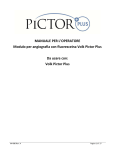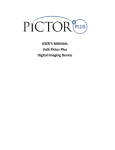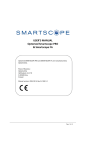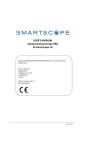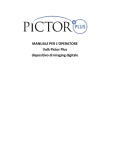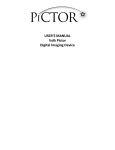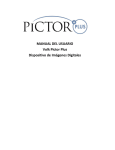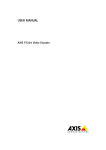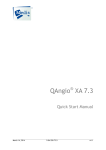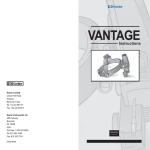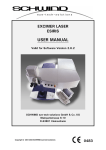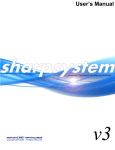Download Optomed M5 Instructions for Use
Transcript
USER’S MANUAL Volk Pictor Plus Fluorescein Angiography (FA) Module For Use with: Volk Pictor Plus IM-080 Rev. A Page 1 of 16 THIS SALES PACKAGE INCLUDES: Model: Fluorescein Angiography (VP2FA) IM-080 Description: Module for fundus fluorescein angiography imaging User Manual QUICK START GUIDE WHAT TO DO BEFORE THE FIRST USE: Remove Volk Optical Pictor Plus Fluorescein Angiography module from the sales package and check that all parts are undamaged. NOTE: For more detailed information on the use of the Pictor Plus Handset, VP2HAND, please consult Instructions for Use document IM-071. INDICATIONS FOR USE The Pictor Plus Fluorescein Angiography module VP2FA is a supported optics lens for the Pictor Plus Handset VP2HAND and is intended to capture digital images of the fundus angiograms of the human eye. WARNINGS AND CAUTIONS Use only accessories and battery provided by Volk Optical with this product. Place PC and cradle outside the patient environment (at least 4 feet distance from the patient). Connection between camera and workstation is USB and/or WIFI. Any authorization procedures should be carried out in workstation. Images and videos can be copied from camera to workstation via USB and/or WIFI and then viewed in workstation. USB write protection is on by default. When protection is on this feature will prevent writing to camera memory card from PC when connected to the cradle. In case device has WIFI functionality, USB write protection must be turned off. No modification of this equipment is allowed. IM-080 Rev. A Page 2 of 16 IMPORTANT SYMBOLS Symbol 0086 Description The CE mark on this product indicates it has been tested and conforms to the provisions noted within the 93/42/EEC Medical Device Directive. CE mark with notified body identification number indicates a class IIa product. Read accompanying user documentation indicates that important operating instructions are included in this User’s and Maintenance Manual. Failure to follow these instructions could place the patient or operator at risk. Type BF applied parts. Applied part is a part of Pictor Plus that in normal use necessarily comes into physical contact with the patient. Used to highlight the fact that there are specific cautions associated with the device, which are not otherwise found on the label. Charger polarity symbol, voltage and power 9V, 1.1 A The symbol indicating separate collection for Waste Electric and Electrical Equipment per Directive 2002/96/EC. ME Equipment and ME SYSTEMS that include RF transmitters or that intentionally apply RF electromagnetic energy for diagnosis or treatment shall be labelled with the symbol for non-ionizing radiation. Sticker at the front of the device indicating Volk Optical’s address, integrated general imaging optics focal length and F-number. IM-080 Rev. A Page 3 of 16 PARTS OF THE DEVICE IM-080 Rev. A Page 4 of 16 Soft key indicators: Position Indicator Left soft key Purpose To power on the device To power off the device, with long press Right soft key Open menu with long press LED indicators: The recharging and connection to PC is indicated with green (charging) and blue (connection) LED-lights: Position Indicator Purpose Left LED-indicator Green Active when device is powered on, blinking when charging in cradle. Right LED-indicator Blue Active when device is placed to the cradle and connected to a PC. ATTACHING AND DETACHING OPTICS MODULE CAUTION: Optic modules used with Volk Optical Pictor Plus must include text “PICTOR PLUS” or “PICTOR”. It is not allowed to attach other objects to the bayonet connector. Optics are attached by placing it in front of the bayonet area of the device. Three bayonet legs are placed on the holes and optics is pressed firmly to the device. Optics are released by sliding release button that is located in front of the device above the dual action shutter. IM-080 Rev. A Page 5 of 16 DEVICE MENU - - - - Menu is opened by pressing right soft key for 1s. Menu has six tabs. One is for device settings such as language selection. There is one tab for retinal imaging (RET), fundus angiography (FA), anterior eye imaging (ANT), ear imaging (OTO), skin imaging (DER), and general imaging (DF). Arrow keys are used to move between tabs: use arrow key up until tab is active and use left and right arrow keys to change active tab. Light blue color indicates active tab. Arrow keys change values in the menu. Active value is indicated with light blue color. Changed values are saved by using left soft key (“Ok”) and cancelled by pressing right soft key (“Cancel”). Some values are confirmed by pressing the Middle key. Fluorescein Angiography Imaging Using Optic Modules VP2HAND & VP2FA The Volk Optical FA digital ophthalmic camera is intended to capture digital images of the fundus angiography of the human eye. The device set for fundus angiography imaging consists of: Pictor Plus handset VP2HAND Attachable Pictor Plus FA module VP2FA Eye cup for Pictor Plus VP2ECUP Cradle for charging and image transfer VPCRADLE Infrared is used for targeting image to the eye fundus and blue light is flashed when image is taken. Pupil does not respond to the infrared light so examination is convenient for the patient. Pictor Plus FA has 9 internal fixation targets for the patient to fixate at while imaging. Below section will guide how to control the fixation lights. STEPS FOR RETINAL IMAGING: 1. The examination room should be as dark as possible. 2. Both the patient and the examiner shall be seated while taking the images. 3. When using Pictor Plus FA optics, the device should be mounted on a slit lamp base using Slit lamp Adapter, its mandatory to achieve good images. 4. Either autofocus or manual focus can be used. Autofocus range is -11 to +3 diopters; manual focus range is 20 to +20 diopters. If patient has a refractive error and autofocus is off, focus need to be adjusted: Hyperopia: camera is focused to distance by pressing arrow key up. One click of the key is approximately 2 Diopters. Myopia: camera is focused closer by pressing arrow key down. One click of the key is approximately 2 Diopters. 5. Aiming light is automatically turned on when camera enters live view. 6. The middle fixation target is lit when pressing left soft key and it provides a macula centred image. To change the fixation target press Left Soft Key and use arrow keys to navigate between the 9 targets as shown in the graphics in lower left corner of the display. If fixation target is turned off ask patient to look at a target in a wall 6-9 feet (2-3 meters) behind the operator. IM-080 Rev. A Page 6 of 16 7. Light is adjusted using left and right arrow key. There are altogether 10 brightness levels. Default value is 5. Suitable illumination is typically 2 to 8. Changing illumination brightness affects only the blue capturing flash. 8. Aim help square on the screen guides user when to take image. When retina is not fully in view the square is red. Once the aim is good and retina fully appears on screen the Square turn’s green indicating a good moment for capturing the image. 9. Approaching the eye is started from 4 inches (10 centimetres) distance. Pupil is approached until the reflection from the eye fundus can be seen. The right imaging distance is about 0.8 inch (2 cm). Silicone support must be compressed approximately half way down. Aim help square on the display guides to take image once it turns from red to green. Camera is stabilised by keeping the outer side of the hand against the patient’s forehead. Example of the correct usage position is shown below: 10. Still image is captured by pressing the shutter key all the way down. Video is captured by keeping shutter down. Taken image is displayed on screen until user clears the image by pressing shutter, left or right soft key. Image can be zoomed in instant preview by pressing middle key. There are four zoom levels. Pressing middle key activates the next level. Move around the image by using arrow keys. This Instant Preview can be enabled/ disabled in the Pictor Plus FA optics menu. 11. If multiple patients are examined during one session, new file folder is created for each patient by pressing middle key for over 3 seconds. 12. Transfer images to a PC after capturing images. Images are transferred to the PC when camera is placed to the cradle. Pictor Plus works as any other digital camera. 13. When camera is removed from the cradle it verifies image data storage erase. image data storage is always erased before images are captured of a new patient. IM-080 Rev. A It is recommended that Page 7 of 16 The camera keys function as shown in image below when VP2FA optics module is attached: Below table provides explanations for the key functions: Key Press Short Function Control Fixation target level and selection Long Power On / Off Short Manual / Auto Long Long Open Menu New patient folder Left soft key Right soft key manual focus range is -20 to +20 diopters. Middle key Change brightness Left/Right arrow - Select fixation target Focus manually Up/Down arrow IM-080 Rev. A Explanation Fixation target is off by default and can be turned on by pressing left soft key. Fixation target light has two levels: Low and High. If the patient cannot see the light on low level turn it up to high. Camera is powered on and off by pressing the Left soft key for longer than 2s. Switch between focus modes by pressing Right soft key. Manual focus is on by default. Autofocus range is -11 to +3 diopters, - Select fixation target Enter camera menu by pressing Right soft key for longer than 1s. If multiple patients are examined during a same session, it is recommended to create a new file folder for each patient’s images. New folder is created by pressing middle key for 3 seconds. Icon P at the top of the screen indicates number of the current patient folder. If the current folder does not have any images in it, a new folder cannot be created. Use left and right arrow keys to adjust capture light brightness. Icon above left soft key must be selected (lighter color) to change brightness. Move between 9 internal fixation targets. Icon above left soft key turns to lighter color when fixation target selection mode is active. When manual focus is active use up and down arrow keys to focus. Press arrow key up when patient has myopia. Press arrow key down when patient has hyperopia. Move between 9 internal fixation targets. Icon above left soft key turns to lighter color when fixation target selection mode is active. Page 8 of 16 Table below includes explanations of the FA settings tab for fundus Angiography imaging: Setting Start Study Values (default bolded) Mark side IR brightness Instant Review On/Off Low/High On/Off Target Blinking On/Off Calibration Frequency (5,10, user) Purpose This enables the study to start. For every new study, user needs to go into the menu and start study to enable the study or Time counter. Mark side of the eye to the image data. Aiming light brightness. Instant review can be ON/OFF according to user need, as available in FA Optics menu. By default the fixation target light is on with constant illumination. If patient cannot keep their eye targeted well the light can changed to blink to help focus on the target light . User can manually set calibration frequency of the optics. Start Study This enables the study to start. For every new study, user needs to go into the menu and start study to enable the study or Time counter. Marking side It is possible to mark which eye was imaged. Marking side is enabled from the menu. When On side is marked to the file name and to the image. For video files, side is always marked only to the file name. When marking side is enabled, camera verifies side after each captured image. Identifiers used for eye images are OS for left and OD for right. IR Brightness IR brightness values are Low/Med/High. This can be chosen by user by using left and right arrow keys. Always high is recommended. Instant review Instant review can be ON/OFF according to user need, as available in FA Optics menu. Target blinking By default the fixation target light is on with constant illumination. If patient cannot keep their eye targeted well the light can changed to blink to help focus on the target light. Calibration Frequency User can manually set calibration frequency of the optics. For Example User selects 5, the device won’t calibrate until next five consecutive images taken. Camera stores selected menu settings when it is powered off. IM-080 Rev. A Page 9 of 16 Menu: 1. Default Display window when FA optics is attached using Manual Mode. You can adjust the Diopter scale according to patient diopter manually. Image can be taken when shutter button held all the way down. 2. op:FA Optics recognized as FA for fundus angiography imaging. 3. Default Display window when FA optics is attached using AF Assist mode. Diopter scale is automatically adjusted, Image can be captured when shutter button is pressed half a way. 4. Default Display window when FA optics is attached using MF Assist mode. Diopter scale is manually adjusted, Image can be captured when shutter button is pressed half a way. IM-080 Rev. A Page 10 of 16 5. When Right Arrow key is held down all the way, Menu table appears on display. Default Device tab will be ON. By using left and right arrow keys you slide to the next tab. Here FA tab is chosen. Time Counter: Start study is selected from the FA optics menu. After pressing shutter button half way for one time during the live view screen. Time counter will appear on the upper right (pointed with arrow on the image). Time counter will be printed on the final images. Time counter will guide you through out through the all phases of Angiography. To stop the time counter after finishing the study, user need to switch to FA optics menu and press the STOP STUDY button. IM-080 Rev. A Page 11 of 16 TECHNICAL DESCRIPTION FUNDUS ANGIOGRAPHY MODULE CONNECTED TO THE PICTOR PLUS M5 CAMERA Type: Intended use: Pictor Plus FA Intended to capture digital images of the fundus angiograms of the human eye. Illumination: Infrared LED for targeting Blue LED for photographing, 10 illumination brightness levels 9 red internal fixation target LEDs 2 Maximum Luminance output 8.07 cd/cm level towards eye: Field of view: Diopter compensation: Image resolution: Dimensions: Weight: 40⁰ - 20 D to + 20 D 1536x1152 px (total 1.8 Mpix, informational area 1.41 Mpix) 160x73mm 310 g ENVIRONMENTAL CONDITIONS FOR USE, STORAGE, AND TRANSPORTATION: IP Code: IPX0 (Equipment not protected against the ingress of water) Use environment: Intended to be use indoors Temperature, use: + 10 C to 35 C Relative humidity, use: 10 % to 80 % Atmospheric pressure: 800 hPa to 1060 hPa NOTE: EMC information given in Annex A. Temperature, storage - 10 C to 40 C Relative humidity, storage: 10 % to 95 % Atmospheric pressure: 500 hPa to 1060 hPa NOTE: If stored over 1 month, it is recommended to remove battery. Transported in protective aluminium carrying case: Temperature: - 40 C to + 70 C Relative humidity: 10 % to 95 % Atmospheric pressure: 500 hPa to 1060 hPa Sinusoidal vibration: 10 Hz to 500 Hz: 0,5 g Shock: 30 g, duration 6 ms Bump: 10 g, duration 6 ms CONTACT If you wish to contact your local support personnel please call to: 800-345-8655 or email us at: service@Volk Optical.com WARRANTY Volk Optical gives device a 1 year warranty for the parts and labor. Warranty for battery is 6 months. Submitting claim: Any claim under this warranty must be submitted in writing before the end of warranty period to Volk Optical. The claim must include a written description of the failure that the device have. Warranty does not cover: Products that have been subjected to abuse, accident, alternation, modification, tampering, misuse, faulty installation, lack of reasonable care, repair or service in any way that is not contemplated in the documentation of the product, or if the model or serial number has been altered, tampered with, defaced or removed. Warranty does not cover damage caused by dropping the device or damage caused by normal wearing. Any issue related to the stickers attached to the device coming off are not covered by warranty. Repair or service done by non Volk Optical certified service facility is not covered by warranty. For customer support, contact: [email protected] IM-080 Rev. A Page 12 of 16 Appendix A - Electromagnetic compatibility information MEDICAL ELECTRICAL SYSTEM needs special precautions regarding EMC and needs to be installed and put into service according to the EMC information provided. Portable and mobile RF communications equipment can affect MEDICAL ELECTRICAL SYSTEM. Pictor Plus should not be used adjacent to or stacked with other equipment and that if adjacent or stacked use is necessary, the EQUIPMENT or SYSTEM should be observed to verify normal operation in the configuration in which it will be used. Manufacturer’s declaration – electromagnetic immunity: PICTOR PLUS is intended for use in the electromagnetic environment specified below. The customer or the user of the Pictor Plus should assure that it is used in such an environment. Immunity test IEC 60601 test level Electromagnetic environment – guidance Floors should be wood, concrete or ceramic tile. If floors are covered with synthetic material, the relative humidity should be at least 30 %. <5 % UT (>95 % dip in UT ) for 0,5 cycle 40 % UT (60 % dip in UT ) for 5 cycles 70 % UT (30 % dip in UT ) for 25 cycles <5 % UT (>95 % dip in UT ) for 5 sec Compliance level ± 2 kV, ± 4 kV, ± 6 kV indirect contact ± 2 kV, ± 4 kV, ± 6 kV contact ± 2 kV, ± 4 kV, ± 8 kV air ±2 kV for AC power supply ±1 kV for serial cable ± 1 kV for AC power supply, 1 Phase without Protective Earth Manufacturer’s test shows conformance to the requirements of the IEC 61000-411/EN 61000-411 Electrostatic discharge (ESD) IEC 61000-4-2 ±6 kV contact ±8 kV air Electrical fast transient/burst IEC 61000-4-4 ±2 kV for power supply lines ±1 kV for input/output lines Surge IEC 61000-4-5 ±1 kV line(s) to line(s) ±2 kV line(s) to earth Voltage dips, short interruptions and voltage variations on power supply input lines IEC 61000-4-11 Power frequency (50/60 Hz) magnetic field IEC 61000-4-8 3 A/m 3 A/m Power frequency magnetic fields should be at levels characteristic of a typical location in a typical commercial or hospital environment. Mains power quality should be that of a typical commercial or hospital environment. Mains power quality should be that of a typical commercial or hospital environment. Mains power quality should be that of a typical commercial or hospital environment. If the user of the Pictor Plus requires continued operation during power mains interruptions, it is recommended that the Pictor Plus be powered from an uninterruptible power supply or a battery. NOTE UT is the a.c. mains voltage prior to application of the test level. IM-080 Rev. A Page 13 of 16 Guidance and manufacturer’s declaration – electromagnetic immunity: The Pictor Plus is intended for use in the electromagnetic environment specified below. The customer or the user of the Pictor Plus should assure that it is used in such an environment. Immunity test IEC 60601 test level Compliance level Electromagnetic environment – guidance Portable and mobile RF communications equipment should be used no closer to any part of the Pictor Plus, including cables, than the recommended separation distance calculated from the equation applicable to the frequency of the transmitter. Recommended separation distance Conducted RF IEC 61000-4-6 3 Vrms 150 kHz to 80 MHz 3 Vrms d = 1.2 √ d = 1.2√ 80 MHz to 800 MHz d = 2.3√ 800 MHz to 2.5 GHz where P is the maximum output power rating of the transmitter in watts (W) according to the transmitter manufacturer and d is the recommended separation distance in metres (m). Radiated RF IEC 61000-4-3 3 V/m 80 MHz to 2.5 GHz 3 V/M Field strengths from fixed RF transmitters, as determined by an electromagnetic site survey, a should be less than the compliance level in each frequency range. Interference may occur in the vicinity of equipment marked with the following symbol: NOTE 1 At 80 MHz and 800 MHz, the higher frequency range applies. NOTE 2 These guidelines may not apply in all situations. Electromagnetic propagation is affected by absorption and reflection from structures, objects and people. a) Field strengths from fixed transmitters, such as base stations for radio (cellular/cordless) telephones and land mobile radios, amateur radio, AM and FM radio broadcast and TV broadcast cannot be predicted theoretically with accuracy. To assess the electromagnetic environment due to fixed RF transmitters, an electromagnetic site survey should be considered. If the measured field strength in the location in which the Pictor Plus is used exceeds the applicable RF compliance level above, the Model 006 should be observed to verify normal operation. If abnormal performance is observed, additional measures may be necessary, such as re-orienting or relocating the Pictor Plus. b) Over the frequency range 150 kHz to 80 MHz, field strengths should be less than 3 V/m. IM-080 Rev. A Page 14 of 16 Manufacturer’s declaration – electromagnetic emissions: PICTOR PLUS is intended for use in the electromagnetic environment specified below. The customer or the user of the Pictor Plus should assure that it is used in such an environment. Compliance Electromagnetic environment – guidance Emissions test level Uses RF energy only for its internal function. Therefore, its RF RF emissions CISPR 11 Group 1 emissions are very low and are not likely to cause any interference in nearby electronic equipment. RF emissions CISPR 11 Class B Harmonic emissions IEC 61000- Not 3-2 applicable Voltage fluctuations/ flicker emissions Complies IEC 61000-3-3 Is suitable for use in all establishments, including domestic establishments and those directly connected to the public low-voltage power supply network that supplies buildings used for domestic purposes. Recommended separation distances between portable and mobile RF communications equipment and the Volk Optical Pictor Plus: The Pictor Plus is intended for use in an electromagnetic environment in which radiated RF disturbances are controlled. The customer or the user of the Volk Optical Pictor Plus can help prevent electromagnetic interference by maintaining a minimum distance between portable and mobile RF communications equipment (transmitters) and the Volk Optical Pictor Plus as recommended below, according to the maximum output power of the communications equipment. Rated maximum output power of transmitter W Separation distance according to frequency of transmitter m 150 kHz to 80 MHz 150 kHz to 80 MHz 800 MHz to 2.5 GHz d = 1.2 √ d = 1.2√ d = 2.3√ 0.01 0.12 0.12 0.23 0.1 0.38 0.38 0.73 1 1.2 1.2 2.3 10 3.8 3.8 7.3 100 12 12 23 For transmitters rated at a maximum output power not listed above, the recommended separation distanced in metres (m) can be estimated using the equation applicable to the frequency of the transmitter, where P is the maximum output power rating of the transmitter in watts (W) according to the transmitter manufacturer. NOTE 1 At 80 MHz and 800 MHz, the separation distance for the higher frequency range applies. NOTE 2 These guidelines may not apply in all situations. Electromagnetic propagation is affected by absorption and reflection from structures, objects and people. IM-080 Rev. A Page 15 of 16 ORDERING INFORMATION Orders may be placed with the Authorized Volk Optical Distributor in your region. Authorized Distributor contact information is available directly from Volk Optical. Volk Optical Inc. 7893 Enterprise Drive Mentor, Ohio 44060 USA Toll free within the United States: 1-800-345-8655 Phone: 440 942 6161 Fax: 440 942 2257 Email: [email protected] Website: www.volk.com EU REPRESENTATIVE The Volk authorized representative based in the European Union (EU) is: Keeler Limited Clewer Hill Road Windsor Berkshire SL4 4AA U.K. Tel: +44(0) 1753 857177 0086 Note: This product complies with current required standards for electromagnetic interferences and should not present problems to other equipment or be affected by other devices. As a precaution, avoid using this device in close proximity to other equipment. Members of the European Union should contact their authorized Volk Distributor for disposal of this unit. Certificate FM 71461 Copyright © 2014 Volk Optical Inc. IM-080 Effective: July 9, 2014 Revision: A IM-080 Rev. A Page 16 of 16


















